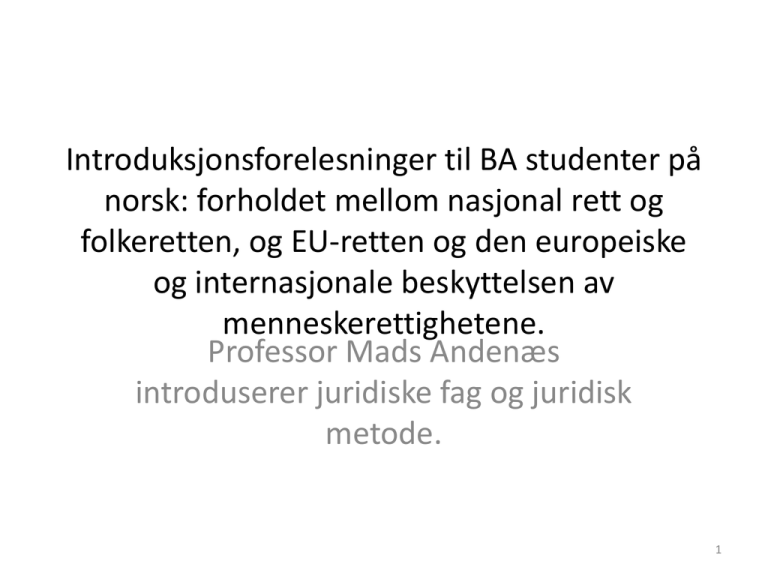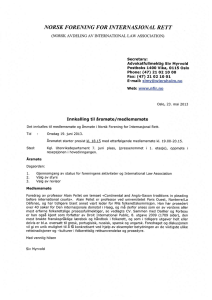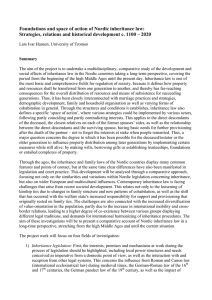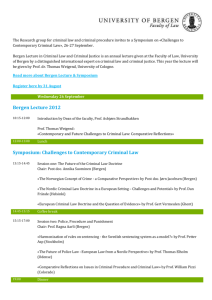Law
advertisement

Introduksjonsforelesninger til BA studenter på norsk: forholdet mellom nasjonal rett og folkeretten, og EU-retten og den europeiske og internasjonale beskyttelsen av menneskerettighetene. Professor Mads Andenæs introduserer juridiske fag og juridisk metode. 1 Program for dagen 1015-1100: Law and legal systems. Norwegian law, international law, European Union law, human rights protection at the different levels. What are sources of law and how do lawyers reason. 1115-1200: Introduction to the EU legal system 1215-1300: International law and its sources 1315-1400: Using legal texts: statutes, treaties and cases 1415-1500: Trying the new tools: reading out, in and down, looking around, behind and ahead and other legal games. 2 Format • Lectures • Interactive parts • Exercises, groups 3 Law and legal systems Norwegian law, international law, European Union law, human rights protection at the different levels. What are sources of law and how do lawyers reason. 4 Bruken av tekster • Tekster, analyse og tolkning • Autoriserte tekster • Hva kan “tolkning” bety? Eksegese 5 Det nasjonale rettssystemet • • • • • Rettskapning og rettshåndhevelse Lovgivning Offentlig forvaltning Private parter Domstoler 6 Forfatningsprinsipper • Maktfordeling • Rettstaten og rettsikkerheten 7 Rettskilder i det nasjonale systemet • • • • Grunnlov Lov Rettspraksis Annen praksis Rettspositivisme og rettsrealisme i den norske tradisjonen. Rettssystemet som bærer av verdier og prinsipper. Nasjonale rettskilder og samhandlingen med folkerettslige, menneskerettslige og EU-rettskilder. 8 Forskjeller i rettskildene mellom nasjonale systemet • Grunnlov: ikke alle land har en skreven grunnlov • Lov: betydningen av lovgivningen og lovfestingen av generelle regler varierer • Rettspraksis: særlig i common law-landene anerkjennes rettsparksis som mer sentral eller viktigere rettskilde. Må ta mange • Annen praksis Rettspositivisme og rettsrealisme i den norske tradisjonen. Rettssystemet som bærer av verdier og prinsipper. 9 Tolkningslæren • Tolkning av grunnlov, lov og rettspraksis. • Forholdet til folkerettslige, menneskerettslige og EU-rettskilder. 10 Domstolene • Hierarkisk system • Prejudikater 11 Introduksjon til EU-retten EU-rettens prinsipper om fortrinn og direkte virking. Rettskildene i EU-retten Traktatene Direktiver Forskrifter 12 Domstolene i EU-retten • • • • ECJ CFI Medlemslandenes domstoler Art 234 EC 13 1. Principal themes that underpin an understanding of the nature and purpose of the European Community Legal order include 14 2. ‘Task expansion’ – a summary Article 5(1) EC: ‘The Community shall act within the limits of the powers conferred upon it by this Treaty and of the objectives assigned to it therein.’ 15 3. The origins of the modern patterns of European integration: the immediate post-1945 debate ‘There are only two kinds of countries in Europe today – those that are small and know it, and those that are small and do not’ (Paul-Henri Spaak) 16 4. Peace – Politics – Economics – Law 17 5. The Treaties and EC lawmaking (distinguish between negative law and positive law) The ‘negative law’ provisions: including free movement, competition law – most prominently Articles 81 and 82 EC. Where competition fits in the map of EC trade law. Competition and Integration. 18 ‘Positive law’. What is now Article 5(1) EC – the principle of ‘attributed competences’ or ‘enumerated powers’. Specific provisions granting particular legislative powers are scattered throughout the text of the Treaty. Regulations, Directives, Decisions; and ‘soft law’: [now Article 249 EC] 19 6. The ‘Community method’. The ‘Market without a State’ ‘Contrary to expectations, the introduction of free markets, far from doing away with the need for control, regulation and intervention, enormously increased their range’ (Karl Polanyi, writing in 1944, quoted at p.1 of M. Egan, Constructing a European Market (Oxford University Press, 2001). 20 7. The development of the system – geographical and functional expansion 21 Accessions (from 6 Member States to 25) 22 The Single European Act (into force 1987) The Treaty of Maastricht (or the Treaty on European Union, into force 1993) The Amsterdam Treaty (into force on 1st May 1999) The Nice Treaty (into force on 1st February 2003) 23 8. Institutional reforms/adjustment to the scope of legislative competence: the rise of subsidiarity as a controlling device Article 5(2) EC: In areas which do not fall within its exclusive competence, the Community shall take action, in accordance with the principle of subsidiarity, only if and in so far as the objectives of the proposed action cannot be sufficiently achieved by the Member States and can therefore, by reason of the scale or effects of the proposed action, be better achieved by the Community. 24 9. The Treaty establishing a Constitution for Europe (?) 25 10. Community method: the constitutional dimension 26 11. Supremacy of EC Law Case 6/64 Costa v. ENEL [1964] ECR 585 … the law stemming from the Treaty, an independent source of law, could not, because of its special and original nature, be overridden by domestic legal provisions, however framed, without being deprived of its character as Community law and without the legal basis of the Community itself being called into question. Case C-213/89 Factortame [1990] ECR I-2433 Case 11/70 Internationale Handelsgesellschaft [1970] ECR 1125 27 12. The direct effect of EC law Case 26/62 Van Gend en Loos [1963] ECR 1 28 13. The effect of EC secondary legislation in the legal orders of the Member States 29 14. The principle of liability for violation of EC law Cases C-6, C-9/90 Francovich v. Italian State [1991] ECR I-5357 Joined Cases C-46/93 and C-48/93 Brasserie du Pêcheur SA v. Germany and R v. Secretary of State for Transport, ex parte Factortame Ltd. and others [1996] ECR I-1029 Case C-392/93 R v. HM Treasury, ex parte British Telecommunications [1996] ECR I-1631 Case C-224/01 Gerhard Köbler v. Austria [2003] ECR I-10239 30 Case C-453/99 Courage Ltd. V. Bernard Crehan [2001] ECR I-6297 ‘The full effectiveness of Article [81] of the Treaty and, in particular, the practical effect of the prohibition laid down in Article [81(1)] would be put at risk if it were not open to any individual to claim damages for loss caused to him by a contract or by conduct liable to restrict or distort competition. Indeed, the existence of such a right strengthens the working of the Community competition rules and discourages agreements or practices, which are frequently covert, which are liable to restrict or distort competition. From that point of view, actions for damages before the national courts can make a significant contribution to the maintenance of effective competition in the Community. There should not therefore be any absolute bar to such an action being brought by a party to a contract which would be held to violate the competition rules’ (paras 26-28) 31 15. ‘Constitutionalism’ So: what happens if there is a violation of EC law? The principle of ‘dual vigilance’ – applied generally, and applied to the particular case of the competition rules. The role of (i) the Commission and (ii) private enforcement before national courts. 32 16. Concluding remarks: How EC law penetrates national legal orders, and the role of national judges in the application of EC law. 33 The European Community – and more recently the wider European Union – has always been profoundly concerned with politics and economics. Its legal order is a means to an end – though the precise nature of that ‘end’ remains contested. 34 Much of the constitutional force of EC law derives not from the explicit terms of the EC Treaty, but rather from the Court’s view of what is required of the legal order in order to achieve the objectives of the Treaty. 35 The result of that process pioneered by the Court has been a ‘constitutionalised’ legal order for the European Community. EC law is international Treaty law – but it is more than international Treaty law 36 The story of the European Union is a story of ‘task expansion’. This is increasingly visibly problematic – for reasons of a symbolic and a practical nature. 37 In the field of competition law, we will need to consider objectives, institutional (political and judicial). Treaty provisions and secondary legislation, the constitutional character of the law of the EC, and patterns of enforcement. Some features of EC competition law are special, most are not. EC competition law is not a world that is separate from general EC law. And – like general EC law – EC competition law is not static. It evolves. 38 Folkeretten • Det tradisjonelle utgangspunktet: reguleringen av forholdet mellom stater med avtaler dem i mellom og statenes praksis som rettskilde. • “Konstitusjonalisering” av folkeretten. • Privates (ikke-stater) stilling. • Internasjonal menneskerettsbeskyttelse. 39 Rettskildene i folkeretten • Traktater og konvensjoner (avtaler mellom stater) • Statenes praksis • “Konstitusjonalisering” av folkeretten. • Privates (ikke-stater) stilling. • Internasjonal menneskerettsbeskyttelse. 40 Regler som ikke kan fravikes i folkeretten 41 “Uferdig” eller “desentralisert”? • Flere regelkretser • Håndhevelse 42 Internasjonale domstoler • Folkerettsdomstolen i Haag (ICJ) • Krigsforbryterdomstolen (ICC) • Forskjellige traktatorganer 43 Using legal texts: statutes, treaties and cases Se utdelt materiale 44 Trying the new tools: reading out, in and down, looking around, behind and ahead and other legal games Reading out Reading in Reading down Looking around Looking behind Looking ahead 45



